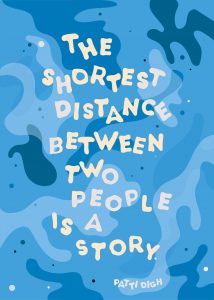3.4 Connecting Through Storytelling
Linda Macdonald
Learning Objectives
By the end of this chapter, you should be able to
- Explain the importance of incorporating story in presentations
- Describe the effects when hormones are induced through storytelling
- Describe the structure of an effective story
We are bound together by family stories, creation stories, and cultural stories. The stories you share with your family or your sports team or your co-workers create your shared identity. As Jimmy Neil Smith, president of the International Storytelling Center, said, “We are all storytellers. We all live in a network of stories. There isn’t a stronger connection between people than storytelling” (as cited by Van West, 2018, para. 1). Richard Van Camp, a Dogrib Tłı̨chǫ writer from the Dene Nation in the Northwest Territories, confirms the value of stories in creating connection.
“[W]e all ache for stories because we ache for connection. We all crave community, and it is stories, once shared, that bond us.”
Richard Van Camp, Gather: On the joy of storytelling, p. 17
As a business communicator, you can use the power of story to build a connection with your audience. In his 17-minute presentation, David JP Phillips explains how you can use storytelling to trigger audience hormones and stir the feelings you would like to create. At the end of the video, click the green button to submit your answers.
(Direct link to The Magical Science of Storytelling TEDX Talk by David JP Phillips video)
The following slides discuss the common structures of stories in Western, non-Indigenous cultures. As you work through the slides you will craft a story and then think about its narrative flow.
Direct link to embedded video in Slide 7: https://www.youtube.com/watch?v=gHGDN9-oFJE)
Remember the value of storytelling as you prepare for your next interview or presentation. Stories engage your listeners and create a bond. An interviewer may not remember your summer job position and responsibilities, but they will likely remember the story you tell about your efforts with the first-time, homesick camper or the client you delighted with improvements in lawn care. You have a story to tell.
Storytelling Exercises
- Richard Van Camp (2021) says, “It’s through stories that we’ve come to know each other. We trust each other because we’ve trusted each other with our stories. We know each other through our stories. Storytelling = connection = community = joy and comfort = health and survival” (p. 22). Sharing stories develops our relationships. We need to tell them and to hear them. Van Camp says he is a good storyteller because he is a good listener. For years he drove a Handi-Bus for Elders in his hometown of Thebacha (Fort Smith). As he drove the Elders to wherever they wanted to go, he listened and then later recorded their stories. To be an active, engaged listener, Van Camp recommends listening without interrupting and looking at the eyes, face, and hands of the storyteller as they speak. And, he says, always, put your phone down.
Use one of the following prompts Van Camp offers in Gather (pp. 163-164) to tell your group a story, and listen as your group members share theirs.
a. My biggest wish for my family is that we ________, and here’s why________.
b. The funniest thing that happened to me this year is the time ________.
c. I can prove that the world is magic with this story: ________
d. I was given my name because ________.
e. I want to be remembered for ________.
- Because stories are a way to make a connection, it is no surprise that companies often ask behavioural questions in interviews to determine fit with their organization. Behavioural questions ask you to share a story that illustrates a characteristic, for example, initiative, problem-solving, analytical skill, conflict negotiation, or teamwork. Use specific examples in your story, and even when the story asks you to reveal a weakness or mistake, focus on a happy ending with what you learned or were able to achieve. The best way to structure a story in response to a behavioural question is the STAR technique:
S ituation (explain the context or background information for your story; for example, you might need to describe your previous place of employment and your role there)
T ask (describe your responsibility or the problem you were tasked to solve)
A ction (explain what action you took to meet your responsibility or to solve the problem)
R esult (describe what happened as a result of your actions)Telling the result is especially important since without demonstrating how your success was achieved and measured (or how you plan to be successful in the future), your story lacks a satisfying conclusion.
Apply the STAR technique as you practice answering these common interview questions:
a. Tell me about a time when you successfully achieved a goal.
b. Describe a time when you had multiple competing deadlines and how you prioritized the tasks.
c. Tell me about a time when you were on a team that worked exceptionally well together.
d. Describe how you have handled a conflict with a co-worker.
e. Tell me about a mistake you have made and your efforts to correct the error.
f. Explain what equity, diversity, and inclusion (EDI) mean to you. Provide an example of how you have applied EDI principles in your work or school life.
g. Describe a time when you used creativity to solve a problem.
h. Tell me about a time when you showed initiative.
i. Tell me about a time when you had to choose between a personal goal and a professional goal.
j. Tell me about a time when someone did not respond to your request for information or materials needed to complete a task. What did you do?
References
Van Camp, R. (2021). Gather: On the joy of storytelling. University of Regina Press.
Van West, C. (2018). National storytelling festival. In Tennessee encyclopedia. Tennessee Historical Society. https://tennesseeencyclopedia.net/entries/national-storytelling-festival/

